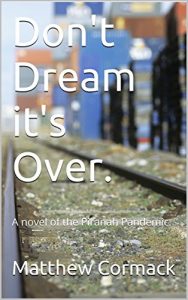With Coronavirus cases now over 750,000 worldwide, deaths over 36,000, and many areas of the US and the world under stay at home orders or lockdown, it might seem like we are experiencing the Apocalypse.
Of course, as I pointed out last week, the Coronavirus while dangerous is nowhere near as deadly as the Spanish Flu of 1918. That bug was killing a million people a week and did so for 25 straight weeks.
But no one today remembers the Spanish Flu Pandemic of 102 years ago.
For that matter, no one remembers the Hong Kong Flu Pandemic of 1968, which killed from one to four million people worldwide. Nor does anyone remember the Asian Flu Pandemic of 1957, which also originated in China, and went on to kill from one to four million people worldwide.
Will Coronavirus be as bad as those flu pandemics? At this stage, we don’t know. Sure experts make guesses — and I emphasize guesses — but even the experts don’t really know. No one will until it’s all over.
Pandemics are a staple in the post-apocalyptic writer’s arsenal of weapons available to wipe out humanity.
However, will a pandemic actually do so? That’s debatable. The Black Death, the most deadly disease to hit the Western world, wiped out 60% of Europe’s population — yet civilization marched on.
Personally, I don’t think a pandemic will be the end of the world as we know it. Not unless the bug that causes it is so foreign and fast acting that we won’t be able to respond in time. Something like the Andromeda Strain.
Be that as it may, pandemics have wiped out humanity in fiction many times over. There are those classics such as Earth Abides by George R Stewart, Empty World by John Christopher, I Am Legend by Richard Matheson, Terry Nation’s TV series and book Survivors, Mary Shelley’s The Last Man, and The Stand by Stephen King.
Indie authors have also jumped on the pandemic bandwagon. Authors such as AJ Newman, Ryan Casey, and AG Riddle.
But as you know, if you are a reader of this blog, I eschew bestsellers. IMO, they usually fail to live up to the hype.
Thus far, I’d have to say the most realistic post-apocalyptic pandemic novels I’ve read are those from the pen of Matthew Cormack.
If you’ve never heard of Matthew Cormack, that’s not surprising. He rather avoids the limelight. He labels himself a “Sunday writer”.
I ran across Mr Cormack in a Facebook writer’s group, where I was looking for some books to read. He offered his book Don’t Dream It’s Over. I read it and loved it. I mean I LOVED IT!!!
Matthew Cormack’s superb world building and very human characters and very realistic situations are what won the day for me.
Don’t Dream It’s Over is the initial novel set in the post-apocalyptic world of the Piranha Pandemic. Don’t Dream was followed by Ganbaru, and the just released The Piranha Pandemic: From Small Acorns… (which I’m very much looking forward to reading).
While the 3 novels are set in the same universe, each one is a standalone work.
Cormack writes about people. His books aren’t prepper manuals, or EMP exercises. They are books about people and how they act under extreme duress. His characters and the situations they get into are very real. These are people who could be your next door neighbor or your relatives.
If Coronavirus were to wipe out most of us who are breathing today, I think the world left behind would be very much like the one Matthew Cormack has created.
Next week, I’ll go into a bit more detail about the books themselves.
In the meantime, they’re only 99¢ each. Surely 3 bucks isn’t too much for some truly top-notch experiences in a world that might be. Experiences that will make you sit back and say, “Thank God I live in this world and not that one.”
Here are the links to the books:
The Piranha Pandemic: From Small Acorns…
Comments are always welcome! And until next time, happy reading!
Share This!